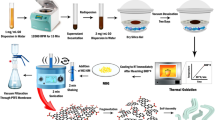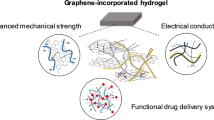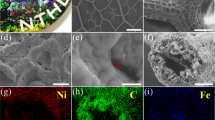Abstract
Graphene has exceptional mechanical and electronic properties1,2,3, but its hydrophobic nature is a disadvantage in biologically related applications4,5. Amyloid fibrils are naturally occurring protein aggregates that are stable in solution or under highly hydrated conditions, have well-organized supramolecular structures and outstanding strength6,7. Here, we show that graphene and amyloid fibrils can be combined to create a new class of biodegradable composite materials with adaptable properties. This new composite material is inexpensive, highly conductive and can be degraded by enzymes. Furthermore, it can reversibly change shape in response to variations in humidity, and can be used in the design of biosensors for quantifying the activity of enzymes. The properties of the composite can be fine-tuned by changing the graphene-to-amyloid ratio.
This is a preview of subscription content, access via your institution
Access options
Subscribe to this journal
Receive 12 print issues and online access
$259.00 per year
only $21.58 per issue
Buy this article
- Purchase on Springer Link
- Instant access to full article PDF
Prices may be subject to local taxes which are calculated during checkout





Similar content being viewed by others
References
Rao, C. N. R., Sood, A. K., Subrahmanyam, K. S. & Govindaraj, A. Graphene: the new two-dimensional nanomaterial. Angew. Chem. Int. Ed. 48, 7752–7777 (2009).
Stankovich, S. et al. Graphene-based composite materials. Nature 442, 282–286 (2006).
Geim, A. K. & Novoselov, K. S. The rise of graphene. Nature Mater. 6, 183–191 (2007).
Patil, A. J., Vickery, J. L., Scott, T. B. & Mann, S. Aqueous stabilization and self-assembly of graphene sheets into layered bio-nanocomposites using DNA. Adv. Mater. 21, 3159–3164 (2009).
Fan, H. et al. Fabrication, mechanical properties, and biocompatibility of graphene-reinforced chitosan composites. Biomacromolecules 11, 2345–2351 (2010).
Cherny, I. & Gazit, E. Amyloids: not only pathological agents but also ordered nanomaterials. Angew. Chem. Int. Ed. 47, 4062–4069 (2008).
Knowles, T. P. J. & Buehler, M. J. Nanomechanics of functional and pathological amyloid materials. Nature Nanotech. 6, 469–479 (2011).
Park, S. & Ruoff, R. S. Chemical methods for the production of graphenes. Nature Nanotech. 4, 217–224 (2009).
Laaksonen, P. et al. Interfacial engineering by proteins: exfoliation and functionalization of graphene by hydrophobins. Angew. Chem. Int. Ed. 122, 5066–5069 (2010).
Han, T. H. et al. Peptide/graphene hybrid assembly into core/shell nanowires. Adv. Mater. 22, 2060–2064 (2010).
Laaksonen, P. et al. Genetic engineering of biomimetic nanocomposites: diblock proteins, graphene, and nanofibrillated cellulose. Angew. Chem. Int. Ed. 50, 8688–8691 (2011).
Park, S. et al. Biocompatible, robust free-standing paper composed of a TWEEN/graphene composite. Adv. Mater. 22, 1736–1740 (2010).
Chung, W-J. et al. Biomimetic self-templating supramolecular structures. Nature 478, 364–368 (2011).
Dvir, T., Timko, B. P., Kohane, D. S. & Langer, R. Nanotechnological strategies for engineering complex tissues. Nature Nanotech. 6, 13–22 (2011).
Nudelman, F. et al. The role of collagen in bone apatite formation in the presence of hydroxyapatite nucleation inhibitors. Nature Mater. 9, 1004–1009 (2010).
Mostaert, A. S. & Jarvis, S. P. Beneficial characteristics of mechanically functional amyloid fibrils evolutionarily preserved in natural adhesives. Nanotechnology 18, 044010 (2007).
Mostaert, A. S. et al. Characterisation of amyloid nanostructures in the natural adhesive of unicellular subaerial algae. J. Adhesion 85, 465–483 (2009).
Losic, D., Martin, L. L., Aguilar, M. & Small, D. H. β-Amyloid fibril formation is promoted by step edges of highly oriented pyrolytic graphite. Pept. Sci. 84, 519–526 (2006).
Gras, S. L. in Engineering Aspects of Self-Organizing Materials (ed. Koopmans, R. J.) 161–209 (Academic, 2009).
Bolisetty, S. et al. Amyloid-mediated synthesis of giant, fluorescent, gold single crystals and their hybrid sandwiched composites driven by liquid crystalline interactions. J. Colloid Interf. Sci. 361, 90–96 (2011).
Jung, J-M., Savin, G., Pouzot, M., Schmitt, C. & Mezzenga, R. Structure of heat-induced β-lactoglobulin aggregates and their complexes with sodium-dodecyl sulfate. Biomacromolecules 9, 2477–2486 (2008).
Adamcik, J. et al. Understanding amyloid aggregation by statistical analysis of atomic force microscopy images. Nature Nanotech. 5, 423–428 (2010).
Bolisetty, S., Adamcik, J. & Mezzenga, R. Snapshots of fibrillation and aggregation kinetics in multistranded amyloid β-lactoglobulin fibrils. Soft Matter 7, 493–499 (2011).
Lara, C., Adamcik, J., Jordens, S. & Mezzenga, R. General self-assembly mechanism converting hydrolyzed globular proteins into giant multistranded amyloid ribbons. Biomacromolecules 12, 1868–1875 (2011).
Zhu, Y. et al. Graphene and graphene oxide: synthesis, properties, and applications. Adv. Mater. 22, 3906–3924 (2010).
Li, D., Muller, M. B., Gilje, S., Kaner, R. B. & Wallace, G. G. Processable aqueous dispersions of graphene nanosheets. Nature Nanotech. 3, 101–105 (2008).
Jung, J-M., Gunes, D. Z. & Mezzenga, R. Interfacial activity and interfacial shear rheology of native β-lactoglobulin monomers and their heat-induced fibers. Langmuir 26, 15366–15375 (2010).
Isa, L., Jung, J-M. & Mezzenga, R. Unravelling adsorption and alignment of amyloid fibrils at interfaces by probe particle tracking. Soft Matter 7, 8127–8134 (2011).
Peng, X., Jin, J., Ericsson, E. M. & Ichinose, I. General method for ultrathin free-standing films of nanofibrous composite materials. J. Am. Chem. Soc. 129, 8625–8633 (2007).
Walther, A. et al. Large-area, lightweight and thick biomimetic composites with superior material properties via fast, economic, and green pathways. Nano. Lett. 10, 2742–2748 (2010).
Knowles, T. P. J., Oppenheim, T. W., Buell, A. K., Chirgadze, D. Y. & Welland, M. E. Nanostructured films from hierarchical self-assembly of amyloidogenic proteins. Nature Nanotech. 5, 204–207 (2010).
Gao, J. et al. Environment-friendly method to produce graphene that employs vitamin C and amino acid. Chem. Mater. 22, 2213–2218 (2010).
Xu, Y., Bai, H., Lu, G., Li, C. & Shi, G. Flexible graphene films via the filtration of water-soluble noncovalent functionalized graphene sheets. J. Am. Chem. Soc. 130, 5856–5857 (2008).
Lee, C., Wei, X., Kysar, J. W. & Hone, J. Measurement of the elastic properties and intrinsic strength of monolayer graphene. Science 321, 385–388 (2008).
Paparcone, R., Keten, S. & Buehler, M. J. Atomistic simulation of nanomechanical properties of Alzheimer's Aβ(1–40) amyloid fibrils under compressive and tensile loading. J. Biomech. 43, 1196–1201 (2010).
Smith, J. F., Knowles, T. P. J., Dobson, C. M., Macphee, C. E. & Welland, M. E. Characterization of the nanoscale properties of individual amyloid fibrils. Proc. Natl Acad. Sci. USA 103, 15806–15811 (2006).
Knowles, T. P. et al. Role of intermolecular forces in defining material properties of protein nanofibrils. Science 318, 1900–1903 (2007).
Adamcik, J., Berquand, A. & Mezzenga, R. Single-step direct measurement of amyloid fibrils stiffness by peak force quantitative nanomechanical atomic force microscopy. Appl. Phys. Lett. 98, 193701 (2011).
Nair, R. R., Wu, H. A., Jayaram, P. N., Grigorieva, I. V. & Geim, A. K. Unimpeded permeation of water through helium-leak-tight graphene-based membranes. Science 335, 442–444 (2012).
Park, S., An, J., Suk, J. W. & Ruoff, R. S. Graphene-based actuators. Small 6, 210–212 (2010).
Bateman, L., Ye, A. & Singh, H. In vitro digestion of β-lactoglobulin fibrils formed by heat treatment at low pH. J. Agric. Food Chem. 58, 9800–9808 (2010).
Jung, J-M. & Mezzenga, R. Liquid crystalline phase behavior of protein fibers in water: experiments versus theory. Langmuir 26, 504–514 (2010).
Marcano, D. C. et al. Improved synthesis of graphene oxide. ACS Nano 4, 4806–4814 (2010).
Acknowledgements
The authors thank S. Handschin for SEM images. H. Adelmann, J. Rao and T. Schweizer are acknowledged for assistance with mechanical, electrical conductivity and thermal gravimetric analysis measurements, respectively.
Author information
Authors and Affiliations
Contributions
C.L. performed the study, the experiments and wrote the paper. J.A. performed the AFM analysis. R.M. designed the study, directed the work and wrote the paper.
Corresponding author
Ethics declarations
Competing interests
The authors declare no competing financial interests.
Supplementary information
Supplementary information
Supplementary information (PDF 10761 kb)
Rights and permissions
About this article
Cite this article
Li, C., Adamcik, J. & Mezzenga, R. Biodegradable nanocomposites of amyloid fibrils and graphene with shape-memory and enzyme-sensing properties. Nature Nanotech 7, 421–427 (2012). https://doi.org/10.1038/nnano.2012.62
Received:
Accepted:
Published:
Issue Date:
DOI: https://doi.org/10.1038/nnano.2012.62
This article is cited by
-
Bioengineered amyloid peptide for rapid screening of inhibitors against main protease of SARS-CoV-2
Nature Communications (2024)
-
Characteristic study of exfoliated graphene particles from waste batteries
Brazilian Journal of Chemical Engineering (2021)
-
Enzyme-Free Glucose Biosensors Based on MoS2 Nanocomposites
Nanoscale Research Letters (2020)
-
Polypeptide templating for designer hierarchical materials
Nature Communications (2020)
-
Enhanced purification coupled with biophysical analyses shows cross-β structure as a core building block for Streptococcus mutans functional amyloids
Scientific Reports (2020)



